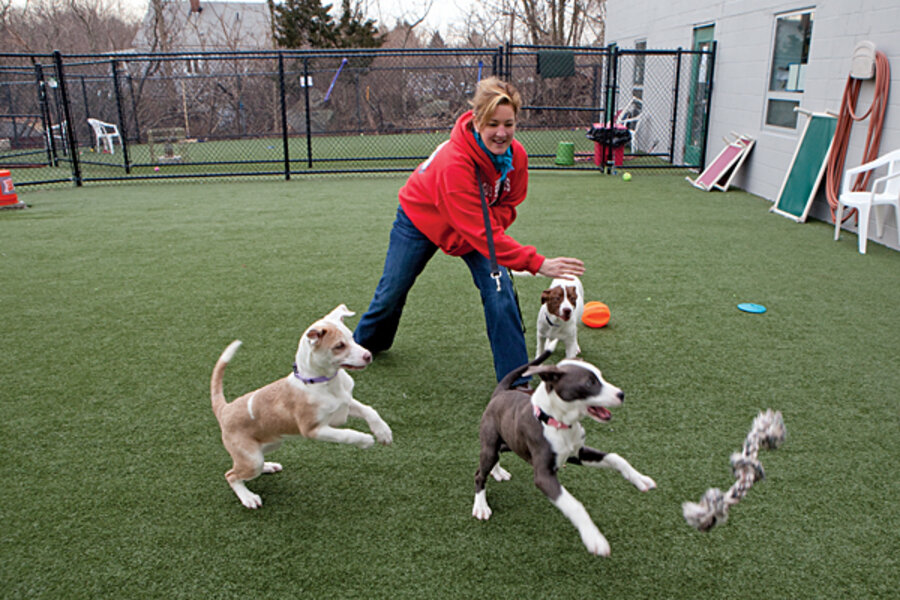Behind the big drop in euthanasia for America's dogs and cats
Loading...
Fewer dogs and cats than ever before are being put to death at animal shelters across the United States. Instead they're living out their lives in pet-care facilities or with families.
The number of animals euthanized each year has decreased dramatically over the past four decades, from some 20 million in 1970 to about 3 million in 2011. Meanwhile, the number of pets has more than doubled since the 1970s, to about 160 million dogs and cats, according to the American Society for the Prevention of Cruelty to Animals.
The decline represents a big shift in the standard of care for America's pets – at shelters and by pet owners, say animal welfare experts.
"There's much more awareness of appropriate pet ownership nowadays," says Inga Fricke, director of sheltering and pet care issues at the Humane Society of the United States (HSUS). "The progress that we have made in reducing shelter euthanasia rates shows not only a huge change in rescue operations but also positive trends that have transformed the way people care for pets."
Chief among them, Ms. Fricke says, is the higher priority put on spaying and neutering stray animals and new pets.
In the 1970s, animal shelter populations and euthanasia rates hit their peak. Overrun with stray animals, shelters routinely "put to sleep" animals they couldn't make room for, Fricke says. "That is the lowest point anyone can remember, when we were euthanizing some 20 million animals every single year," she says. "They were healthy and adoptable animals that no one wanted and no one had homes for."
That began to change when the first low-cost spay/neuter clinic opened in 1971 in Los Angeles, and the number of animals handled annually by shelters has declined rapidly ever since, according to HSUS data. Indeed, sterilization is practiced much more routinely in shelters today, to strike at the root of animal overpopulation and to find a closer balance between available animals and adoptive homes.
"It has become the standard practice of care," Fricke says. "Years ago, no one really thought or cared about it, but today, it's the exception to have an animal that's not [sterilized]. You make sure [your pet] is spayed or neutered the same way it's properly groomed and taken care of."
It's no small expense. While fees for spaying or neutering a pet vary widely by region, by clinic, and by the size of the animal, the bill often runs into the hundreds of dollars. That people are willing to incur such a cost speaks to the magnitude of the shift in attitude toward the importance of animal population control.
Sterilization is the biggest reason for the decline in shelter euthanasia, says Andrew Rowan, chief scientific officer of HSUS, but it's not the only reason. "There's more of a pet culture today," he says. "People who want dogs have dogs. People who don't want them don't, and they don't have them living outside on their street either."
Still, 5 million to 7 million companion animals enter shelters nationwide each year. Along with spaying and neutering, rescue operations focus on the broader concern for animal welfare, says Cindi Shapiro, president of the Northeast Animal Shelter in Salem, Mass.
Founder of one of the largest no-kill animal shelters in the Northeast, Ms. Shapiro says the mind-set of shelter workers has shifted over time.
"In the past, it was acceptable to throw an animal away, the way you would an old television set," she says. "You would just bring them to the shelter and dump the old dog you don't want anymore."
Shelter personnel were no different, she continues. "For a long time, it's just what you did," she says. "[Animals] came in; you killed them. No one thought that was wrong."
Now, Shapiro says, fewer people see pets as disposable. "Very slowly, people have begun to understand that the lives of cats and dogs have value and that owning a pet is a privilege, not a right."
Shapiro says her shelter took in about 4,200 dogs and cats from overpopulated shelters around the US last year. Since opening in 1976, the shelter has placed about 105,000 pets into adoptive homes.
Thanks to careful planning and a detailed understanding of how many animals the shelter can realistically place in homes, no animal that enters the shelter stays permanently, Shapiro says. Two months has been the longest stay for any animal before being adopted.
There are no firm statistics on no-kill animal shelters in the US, but their numbers appear to be rising, experts say. Moreover, cities with no-kill shelters, such as Reno, Nev., have seen a boost in animal adoptions. Cat adoptions in Reno nearly doubled and dog adoptions increased by 51 percent within a year of putting the no-kill policy in place in 2006.
Shelters, most of which are funded with taxpayer dollars, and pet owners spend more to care for stray and neglected animals these days, according to Mr. Rowan. In 1975 they spent about $1 billion on animal protection, versus $2.8 billion as of 2007, he says, noting the figures are in inflation-adjusted dollars.
"When an animal crosses that threshold and into our care, it's ours, no matter what care they need," says Shapiro, in Salem. "Whether it's medical, behavioral, training – whatever we need to do to make them adoptable, we'll do it."








